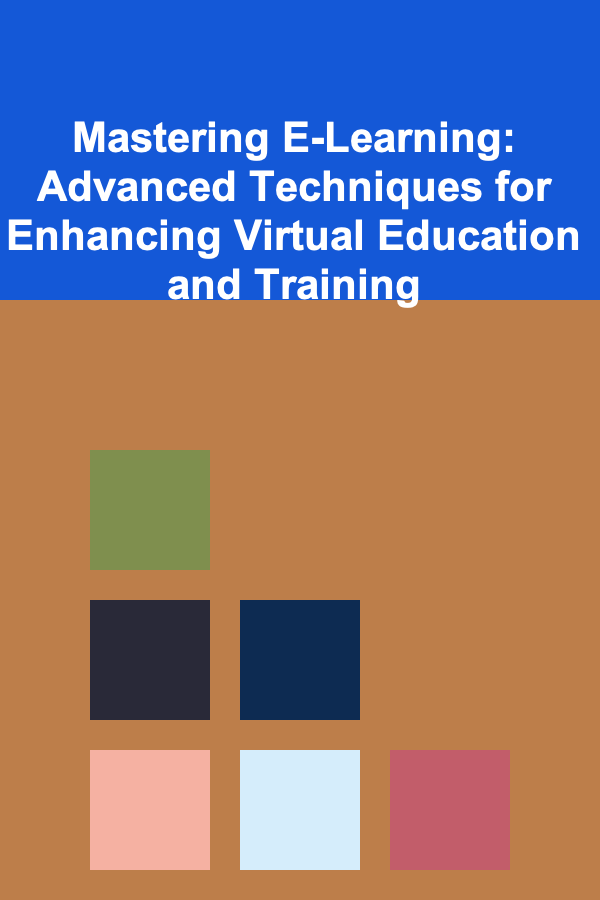
Mastering E-Learning: Advanced Techniques for Enhancing Virtual Education and Training
ebook include PDF & Audio bundle (Micro Guide)
$12.99$5.99
Limited Time Offer! Order within the next:

In recent years, e-learning has become a cornerstone of education and training, revolutionizing how we access information and engage with content. From academic courses to corporate training, the shift to virtual learning has been accelerated by technological advancements and global events, such as the COVID-19 pandemic. As e-learning continues to evolve, the need for effective, engaging, and impactful virtual education is more critical than ever.
This guide explores advanced techniques for mastering e-learning, providing educators, trainers, and instructional designers with actionable strategies to enhance virtual education and training experiences.
Embracing Learner-Centric Design
At the heart of effective e-learning is the concept of learner-centric design. Traditional learning environments often place the instructor at the center, with the assumption that students will absorb information in a passive manner. However, virtual education offers an opportunity to turn this model on its head by focusing on the needs, preferences, and learning styles of individual learners.
Personalized Learning Paths
One of the most powerful techniques in e-learning is the ability to create personalized learning paths. Personalized learning tailors the content and pace to meet the needs of each learner, allowing them to progress at their own speed. This can be achieved by:
- Adaptive Learning Systems: Use algorithms that analyze learner behavior and performance to adjust the content in real-time. These systems can recommend resources based on quiz results, assignments, and even participation in discussions, ensuring learners focus on areas where they need improvement.
- Modular Learning: Break down the content into smaller, digestible modules. This not only improves engagement but also allows learners to choose the modules they need based on their goals or current knowledge.
- Learning Analytics: Leverage data to understand how learners are interacting with the course. Analytics can help identify bottlenecks or areas where students struggle, allowing you to provide additional resources or modify course content accordingly.
Self-Paced Learning and Microlearning
Incorporating self-paced learning options allows learners to engage with material on their own terms. Microlearning, in particular, plays a significant role in this. By delivering content in short, focused bursts, learners can absorb and retain information more effectively.
- Micro-Courses: These are short, targeted lessons designed to teach specific skills or concepts in a brief period. For instance, a micro-course on using a new software tool might last only 10-15 minutes but delivers actionable knowledge.
- On-Demand Learning: Provide learners with access to resources they can consume whenever they need. This flexibility is crucial in today's fast-paced world, where learners may need to revisit content quickly without having to wait for scheduled lessons.
Interactive and Immersive Learning Techniques
Engagement is a critical component of e-learning. When learners are actively involved in their learning process, they are more likely to retain information and develop practical skills. This can be achieved through a variety of interactive and immersive techniques.
Gamification
Gamification introduces game elements into the learning experience to make it more engaging. By incorporating elements like points, leaderboards, badges, and challenges, you can create a competitive and rewarding environment that motivates learners to actively participate.
- Progression and Rewards: Similar to video games, learners can "level up" by completing modules or achieving certain milestones. These rewards can be both intrinsic (a sense of achievement) and extrinsic (certificates or tangible rewards).
- Quizzes and Puzzles: Instead of traditional tests, use quizzes, riddles, or puzzles that encourage learners to think critically and apply knowledge in creative ways. This transforms assessments into engaging challenges that feel less like a test and more like a game.
Virtual and Augmented Reality (VR/AR)
Virtual and augmented reality technologies have the potential to create highly immersive learning environments, especially for complex or hands-on subjects. These technologies can simulate real-world scenarios, allowing learners to practice skills or interact with 3D models in a safe and controlled environment.
- Simulations: VR can be used to simulate scenarios that learners may not be able to experience in real life, such as medical procedures, flight training, or hazardous work environments.
- Interactive 3D Models: AR allows learners to interact with 3D representations of objects or concepts, helping them better understand abstract ideas or complex systems.
Collaborative Learning
Learning is not only an individual pursuit; it's a social process. Collaborative learning in a virtual environment can promote engagement, knowledge sharing, and peer-to-peer learning. This can be achieved through:
- Group Projects: Assign tasks that require collaboration, encouraging learners to work together in virtual teams. Platforms like Zoom, Microsoft Teams, or Slack can be used for real-time communication and project management.
- Discussion Forums: Create online discussion boards where learners can share ideas, ask questions, and solve problems together. This promotes critical thinking and fosters a sense of community.
- Peer Feedback: Incorporate peer review systems where learners assess each other's work. This provides valuable insights and builds a culture of constructive feedback.
Advanced Assessment and Feedback Techniques
In traditional education settings, assessments are often limited to written exams and papers. E-learning offers a wider range of assessment techniques that provide more accurate insights into a learner's progress and understanding.
Continuous Assessment
Rather than relying solely on a final exam, continuous assessment breaks the learning process into smaller, more manageable evaluations. This method provides ongoing feedback, allowing learners to track their progress and adjust their approach as needed.
- Formative Assessments: These are low-stakes assessments that occur throughout the course, such as quizzes, short assignments, or interactive activities. Formative assessments allow instructors to identify areas where students may need additional support.
- Peer and Self-Assessment: Encouraging students to assess their own work or the work of others not only promotes deeper reflection but also helps them develop critical thinking and evaluative skills.
Data-Driven Feedback
Leverage the power of data analytics to provide detailed, actionable feedback. By analyzing learner performance over time, you can identify patterns, highlight strengths, and offer targeted suggestions for improvement.
- Learning Dashboards: Provide learners with a personalized dashboard that displays their progress, strengths, and areas for improvement. This real-time feedback helps learners stay motivated and focused.
- Instant Feedback: Use tools that provide immediate feedback after assessments, allowing learners to understand their mistakes and correct them in real-time. This type of feedback is particularly effective in improving retention and learning outcomes.
Authentic Assessment
Authentic assessments mirror real-world challenges, requiring learners to apply their knowledge and skills in practical, meaningful ways. Instead of traditional tests, authentic assessments might include:
- Case Studies: Learners analyze real-world problems and develop solutions based on course content.
- Portfolios: Students compile a collection of their work over time, demonstrating the progress they've made and showcasing their achievements.
- Presentations and Demonstrations: Allow learners to present their work in a virtual setting, encouraging communication skills and the ability to explain complex concepts to others.
Leveraging Technology and Tools
The right tools and platforms can significantly enhance the effectiveness of e-learning. A well-integrated technology ecosystem allows instructors to create engaging content, track progress, and facilitate communication.
Learning Management Systems (LMS)
An LMS serves as the central hub for all e-learning activities. Popular platforms like Moodle, Canvas, and Blackboard allow instructors to manage content, deliver lessons, and track student progress.
- Content Management: Upload and organize course materials, quizzes, videos, and assignments in one centralized location.
- Communication Tools: LMS platforms often come with built-in discussion forums, messaging systems, and video conferencing features to facilitate communication between learners and instructors.
- Analytics and Reporting: Most LMS systems offer robust reporting features that provide insights into learner engagement, course completion rates, and performance trends.
Collaborative Tools
Tools like Google Workspace, Microsoft Teams, and Slack can be used for collaboration, communication, and file sharing. These platforms allow learners to work together on projects, hold virtual meetings, and share resources seamlessly.
Video and Multimedia Integration
Video-based learning is one of the most engaging formats in e-learning. Platforms like YouTube, Vimeo, and integrated video conferencing tools can be used to create lecture recordings, tutorials, or interactive discussions. Additionally, incorporating multimedia elements like animations, infographics, and podcasts can make learning more dynamic and engaging.
Conclusion
Mastering e-learning is an ongoing process that requires both innovation and a deep understanding of the learners' needs. By embracing learner-centric design, incorporating immersive technologies, implementing interactive and continuous assessment methods, and leveraging the latest tools, educators and trainers can create more engaging, effective, and impactful virtual learning experiences.
As the landscape of education and training continues to shift, staying up-to-date with these advanced techniques will ensure that you remain at the forefront of e-learning, delivering high-quality, engaging, and results-driven educational experiences.
Reading More From Our Other Websites
- [Personal Care Tips 101] How to Pick the Best Toothbrush for Your Teeth's Enamel
- [Home Rental Property 101] How to Find Apartments with a Balcony in Your Next Rental Property
- [Home Maintenance 101] How to Tackle Minor Siding Repair and Replacement Yourself: Saving Money and Protecting Your Home
- [Home Lighting 101] How to Incorporate Color-Changing Lights into Your Home Decor
- [Personal Care Tips 101] How to Choose the Best Concealer for Under-Eye Puffiness
- [Home Family Activity 101] How to Use Family Stories to Teach History and Values
- [Organization Tip 101] How to Store Paints and Inks Without the Mess
- [Home Holiday Decoration 101] How to Decorate a Holiday Tree with a Specific Theme
- [Organization Tip 101] How to Organize Emergency Kits for Home-Based Businesses
- [Survival Kit 101] How to Maintain a Survival Kit for Year‑Round Use in Variable Climates

10 Simple Tips for Saving on Pet Food and Supplies
Read More
How To Become a Professional Organizer
Read More
How to Establish a System for Seasonal Clothing Changes
Read More
How To Master the Ethics of Social Media Marketing
Read More
How to Use YouTube Video Ads for Retargeting Customers Who Have Viewed Your Dropshipping Products
Read More
How to Design a Daily Dog Training To-Do List for Consistency
Read MoreOther Products

10 Simple Tips for Saving on Pet Food and Supplies
Read More
How To Become a Professional Organizer
Read More
How to Establish a System for Seasonal Clothing Changes
Read More
How To Master the Ethics of Social Media Marketing
Read More
How to Use YouTube Video Ads for Retargeting Customers Who Have Viewed Your Dropshipping Products
Read More